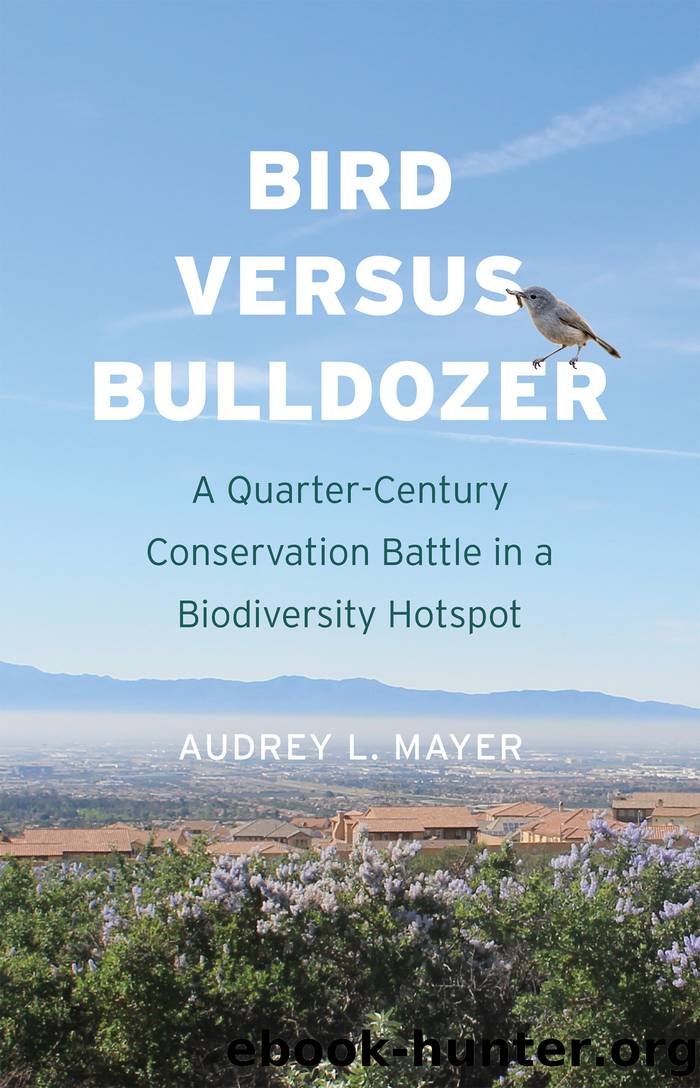Bird versus Bulldozer: A Quarter-Century Conservation Battle in a Biodiversity Hotspot by Audrey L. Mayer

Author:Audrey L. Mayer
Language: eng
Format: epub
Publisher: Yale University Press
Published: 2021-03-14T16:00:00+00:00
From Nature Beyond to Nature Within
Southern California may have unique biodiversity, but the challenges to protect it are not. Throughout the world, as cities swell to absorb millions more humans, urban regions will have to contend with species imperilment, climate change, flooding from impervious areas, invasive species, and novel ecosystems. As the most populous, biodiverse, and fastest growing state in the nation, California can provide valuable lessons to reconcile urban growth with biodiversity conservation and contribute to a broader understanding of conservation in urbanized regions.31
Until now, protection of urban biodiversity has occurred outside of cities; this is by design. Many policies and funding mechanisms seek to concentrate development near urban centers and place preserves and open space in the periphery where land prices are lower. Although that approach protects vulnerable species from urban activity, it sacrifices biodiversity in the urban core and reduces the value of the preserves to urban residents who canât afford to travel out to enjoy them. Much of the 15 percent of global land area that has been protected for biodiversity is established in areas of few human settlements and low biodiversity: mountains, deserts, or high-latitude areas. In Southern California, the vast majority of protected areas are national forests in the mountains and national parks in the deserts (see fig. 5.1). While these areas bring the state close to the international Aichi Biodiversity Target of protecting 17 percent of all terrestrial habitats, scientists are now calling for a preservation target of up to half of all habitatsâa Nature Needs Half campaign target that Southern Californiaâs development has made all but impossible, even with the NCCP policy. Ironically, the movement of rural populations to cities has made this 50 percent target more feasible for all regions except urbanizing ones.32
The conservation conundrum is the same everywhere. Static protected areas far from cities are necessary but not sufficient for long-term biodiversity preservation, particularly as urban sprawl decays the remoteness of these areas. Our larger and increasingly urban population is also becoming more affluent, amplifying demand for food that increases the amount of land dedicated to agriculture. As cities sprawl into agricultural areas, as happened in Southern California in the early twentieth century, farmlands are pushed into natural areas. Migratory species and large carnivores that spend much of their time outside of the small protected areas in the periphery are left wholly unprotected, as they use vast swaths of land and sea that are too large to set aside from human activity.
What can be done? We need to learn how to protect species within our cities.
Download
This site does not store any files on its server. We only index and link to content provided by other sites. Please contact the content providers to delete copyright contents if any and email us, we'll remove relevant links or contents immediately.
The Lonely City by Olivia Laing(4568)
Animal Frequency by Melissa Alvarez(4150)
All Creatures Great and Small by James Herriot(3986)
Walking by Henry David Thoreau(3681)
Exit West by Mohsin Hamid(3634)
Origin Story: A Big History of Everything by David Christian(3472)
COSMOS by Carl Sagan(3346)
How to Read Water: Clues and Patterns from Puddles to the Sea (Natural Navigation) by Tristan Gooley(3239)
Hedgerow by John Wright(3106)
How to Do Nothing by Jenny Odell(3101)
The Inner Life of Animals by Peter Wohlleben(3099)
How to Read Nature by Tristan Gooley(3077)
Project Animal Farm: An Accidental Journey into the Secret World of Farming and the Truth About Our Food by Sonia Faruqi(3018)
Origin Story by David Christian(2991)
Water by Ian Miller(2950)
A Forest Journey by John Perlin(2915)
The Plant Messiah by Carlos Magdalena(2745)
A Wilder Time by William E. Glassley(2689)
Forests: A Very Short Introduction by Jaboury Ghazoul(2671)
